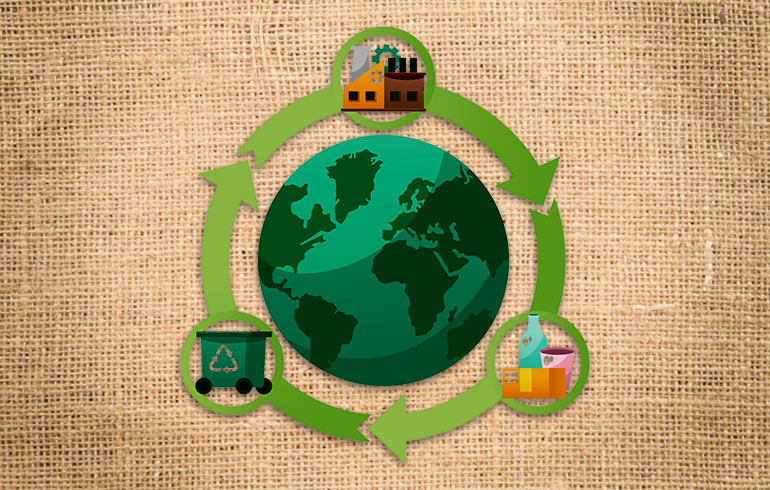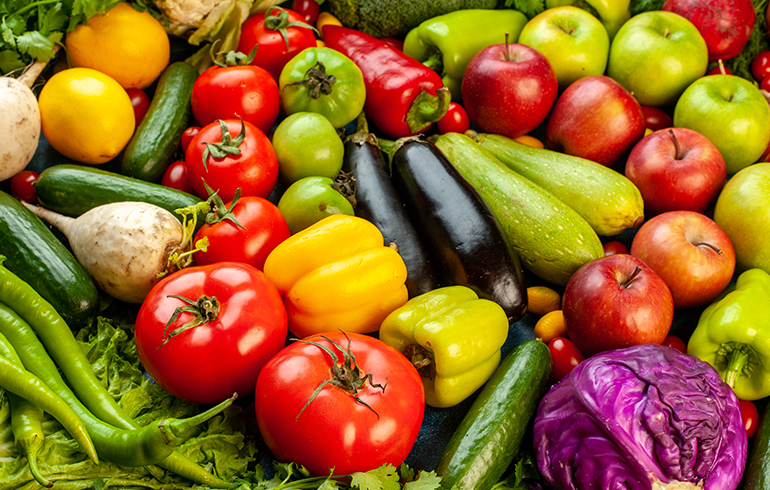
Mitigating climate change with jute, a natural fiber
Jute can be used as a sustainable and eco-friendly material to mitigate the impacts of climate change:
- Jute is a renewable natural resource. Jute can be grown and harvested year after year, without depleting the soil or the environment. In contrast, synthetic fibers, such as polyester and nylon, are made from petroleum, which is a non-renewable resource. Using jute predominately reduces synthetic fibers production which leads to a decrease in the demand of petroleum, a fossil fuel whose extraction contributes to climate change.
- Jute is biodegradable. Jute breaks down in the environment in a short period of time without releasing harmful pollutants. In contrast, synthetic fibers will take from hundreds to thousands of years to decompose, and they will release harmful pollutants into the environment when they do.
- Jute helps sequester carbon dioxide. As jute plants grow, they absorb carbon dioxide, a major greenhouse gas, from the atmosphere. This helps reduce the amount of carbon dioxide in the atmosphere, thereby directly combatting climate change.
- Jute helps prevent soil erosion. Jute plants have a deep root system that holds soil in place. This can help prevent soil erosion, which is a major issue that leads to flooding—a direct effect of climate change in many parts of the world.
Jute is also increasing being used in bio- & environmental-engineering to build technology that can be used to combat climate change through carbon-capture, eco-friendly infrastructure projects, and much more.
CO2 Adsorption on Pore-Engineered Carbons Derived from Jute Sticks
References
Dr. Aamir Hanif, Dr. Md. Abdul Aziz, Dr. Aasif Helal, [Dr. Mahmoud M. Abdelnaby](https://onlinelibrary.wiley.com/authored-by/Abdelnaby/Mahmoud+M.), Mohammed Ameen Ahmed Qasem, Dr. Abuzar Khan, [Dr. Abbas S. Hakeem](https://onlinelibrary.wiley.com/authored-by/Hakeem/Abbas+S.), [Dr. Abdul-Rahman F. Al-Betar](https://onlinelibrary.wiley.com/authored-by/Al‐Betar/Abdul‐Rahman+F.), Dr. Mohd Yusuf Khan … See fewer authors
CO2 capture is a practical approach to mitigating the impacts of global warming. Adsorption-based carbon capture is a clean and potentially energy-efficient method whose performance greatly depends on adsorbent design. In this study, we explored the use of jute-derived carbon as a high-performance adsorbent for CO2 capture. The carbons were produced by pyrolyzing powdered jute sticks with NaHCO3 as an activating agent at 500–700 °C. Impressive adsorption capacities of up to 2.5 mmol ⋅ g−1 and CO2/N2 selectivities of up to 54 were achieved by adjusting the pore size distribution and surface functionalization. Based on the isotherm results, the working capacities, regenerabilities, and potentials for CO2 separation were determined for a practical vacuum swing adsorption process. The adsorbent materials were characterized by XRD, FTIR, Raman, FESEM and N2 sorption at 77 K. This study provides a general approach for designing adsorbents for various gas-separation applications.
Natural fibre-reinforced composites for bioengineering and environmental engineering applications
References
Hoi-yan Cheung, Mei-po Ho, Kin-tak Lau, Francisco Cardona, David Hui, Composites Part B: Engineering, Volume 40, Issue 7, 2009, Pages 655-663, ISSN 1359-8368, https://doi.org/10.1016/j.compositesb.2009.04.014. (https://www.sciencedirect.com/science/article/pii/S1359836809000730)
Abstract: Recently, the mankind has realized that unless environment is protected, he himself will be threatened by the over consumption of natural resource as well as substantial reduction of fresh air produced in the world. Conservation of forests and optimal utilization of agricultural and other renewable resources like solar and wind energies, and recently, tidal energy have become important topics worldwide. In such concern, the use of renewable resources such as plant and animal basedfibre-reinforce polymeric composites, has been becoming an important design criterion for designing and manufacturing components for all industrial products. Research on biodegradable polymeric composites, can contribute for green and safe environment to some extent. In the biomedical and bioengineered field, the use of natural fibre mixed with biodegradable and bioresorbable polymers can produce joints and bone fixtures to alleviate pain for patients. In this paper, a comprehensive review on different kinds of natural fibre composites will be given. Their potential in future development of different kinds of engineering and domestic products will also be discussed in detail. Keywords: A. Polymer-matrix composites (PMCs); B. Mechanical properties; B. Thermal properties; D. Surface analysis.
a. Intergovernmental Panel on Climate Change(IPCC) and Global warming
The Intergovernmental Panel on Climate Change (IPCC) is the United Nations body for assessing the science related to climate change.
Global warming is the long-term increase in the earth's average surface temperature caused primarily by the burning of fossil fuels such as coal, oil, and gas, which releases large amounts of greenhouse gases (GHGs) into the atmosphere. GHGs trap incoming solar thermal energy and prevents it from radiating back into space, thereby raising the Earth's temperature, leading to changes in climate patterns, rising sea levels, and other environmental impacts.
Global warming is steadily increasing and impacting on highly vulnerable developing countries. Agriculture, an essential sector for most of developing countries, contributes to climate change with greenhouse gas emissions (GHG). The challenge of feeding growing populations and reducing agricultural GHG emissionsrequires the successful transfer of climate-friendly agricultural and land use practices to farmers serving adaptation and mitigation of GHGs.
The jute plant has significant potential to absorb and fix carbon dioxide, a major GHG, from the atmosphere.
b. Role of jute in carbon sequestration
Jute plants sequester carbon dioxide during the process of photosynthesis. This process converts carbon dioxide and water into oxygen and glucose. The glucose is used by the plant for metabolism and growth while the oxygen is released into the atmosphere.
Once the jute plant dies, its decomposition releases most of the carbon back into the atmosphere but some of the carbon remains trapped in the soil. The trapped carbon can remain in the soil for hundreds or even thousands of years.
Studies have shown that jute can sequester up to 1.5 tons of carbon dioxide per hectare per year. This is a significant amount of carbon, and it can help mitigate climate change.
In addition to sequestering carbon, jute also has several other environmental benefits. It is a
- Jute is a fast-growing plant, allowing it to absorb a lot of carbon dioxide in a short period of time.
- Jute is a versatile and resilient crop that can be grown in a variety of climatic conditions in tropical and subtropical regions.
- Jute is a sustainable crop that can be grown without a significant impact on the environment since it is relatively low-maintenance and does not require a lot of water or fertilizer compared to other commercial crops.
A study on efficient microbial biodegradation of cellulose based jute composite
References
A. K. Singh, M. S. Behera, S. P. Mazumdar & D. K. Kundu (2019) Soil Carbon Sequestration in Long-Term Fertilization Under Jute-Rice-Wheat Agro-Ecosystem, Communications in Soil Science and Plant Analysis, 50:6, 739-748, DOI: 10.1080/00103624.2019.1589483
“Soil organic carbon (SOC) sequestration in response to long-term fertilizer management practices under jute-rice-wheat agro-ecosystem in alluvial soils was studied using a modeling approach. Fertilizer management practices included nitrogen (N), phosphorus (P) and potassium (K) fertilization, manure application, and root-stubble retention of all three crops. Soil carbon (C) model RothC was used to simulate the critical C input rates needed to maintain initial soil C level in long timescale (44 years). SOC change was significantly influenced by the long-term fertilizer management practices and the edaphic variable of initial SOC content. The effects of fertilizer combination “100%NPK+FYM” on SOC changes were most significant over “100%NPK” fertilization. If the 100% NPK fertilizer along with manure applied with stubble and roots retention of all crops, alluvial soils of such agro-ecosystem would act as a net C sink, and the average SOC density kept increasing from 18.18 Mg ha−1 during 1972 to the current average of ∼22 Mg ha−1 during 2065 s. On an average, the critical C input was estimated to be 5.30 Mg C ha−1 yr−1, depending on local soil and climatic conditions. The critical C input could be effectively estimated using a summary model driven by current SOC level, mean annual temperature, precipitation, and soil clay content. Such information will provide a baseline for assessing soil C dynamics under potential changes in fertilizer and crop residues management practices, and thus enable development of management strategies for effectively mitigating climate change through soil C sequestration.”
c. COP26, COP27and nature-based solutions
COP26 and COP27 were the 26th and 27th Conferences of the Parties to the United Nations Framework Convention on Climate Change (UNFCCC).
The Conference of the Parties (COP) is the world's largest annual climate change summit, and it brings together representatives from over 190 countries to negotiate and agree on global action to address climate change.
COP26 was held in Glasgow, Scotland in from 31 October to 13 November 2021. It was a landmark summit that saw countries agree to several important commitments, including:
- To limit global warming to 1.5 degrees Celsius above pre-industrial levels.
- To phase out coal power and invest in clean energy.
- To provide financial assistance to developing countries to help them adapt to climate change.
COP27 was held in Sharm el-Sheikh, Egypt in from 6 November 2022 to 18 November 2022. The focus was on the implementation of the commitments made at COP26 as well as on the issue of loss and damage caused by climate change.
The two conferences concluded with some significant steps forward in the fight against climate change.
The key outcomes of COP26 and COP27:
- COP26
- Agreement to limit global warming to 1.5 degrees Celsius above pre-industrial levels.
- Agreement to phase down coal power and invest in clean energy.
- Agreement to provide financial assistance to developing countries to help them adapt to climate change.
- COP27
- Establishment of a loss and damage fund to help countries that have been affected by climate change.
- Agreement to work towards a global carbon market.
- Agreement to accelerate the development and deployment of clean technologies.
References
https://unfccc.int/event/cop-27#decisions_reports
https://unfccc.int/conference/glasgow-climate-change-conference-october-november-2021
https://unfccc.int/conference/glasgow-climate-change-conference-october-november-2021
https://unfccc.int/documents?f[0]=conference:4460&f[1]=document_type:375
https://unfccc.int/documents?f[0]=conference:4460&f[1]=document_type:375
References
Aleksandra Ivanovska, Jelena Lađarević, LeposavaPavun, Biljana Dojčinović, Ilija Cvijetić, DušanMijin, Mirjana Kostić, “Obtaining jute fabrics with enhanced sorption properties and “closing the loop” of their lifecycle, Industrial Crops and Products, Volume 171, 2021, 113913, ISSN 0926-6690, https://doi.org/10.1016/j.indcrop.2021.113913. (https://www.sciencedirect.com/science/article/pii/S0926669021006774)



















